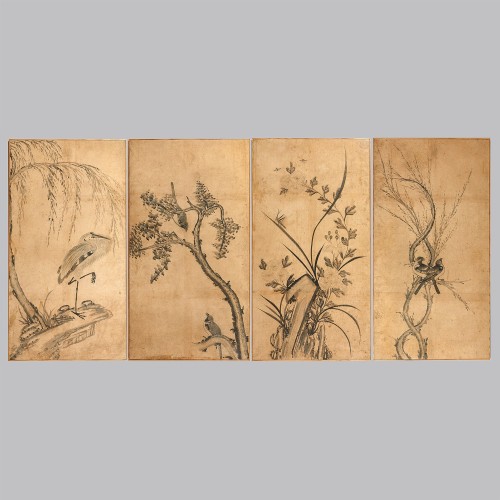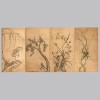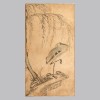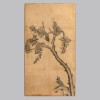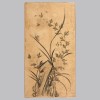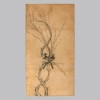본문
사계절의 변화 속에서 화목과 장수를 상징적으로 그려낸 조선시대 화조도입니다.
첫 번째 폭의 버드나무와 왜가리는 새순이 돋고 철새가 돌아오는 봄의 생기를 암시하고, 두 번째 폭의 무성하게 우거진 나뭇잎 사이에 자리한 까치 두 마리는 여름의 짙은 녹음과 더불어 생명력과 길상의 의미를 더합니다. 세 번째 폭에는 가을의 대표 꽃인 국화와 함께 여치가 등장해 풍요와 수확의 계절을 나타내며, 마지막 폭은 마른 가지 위에 앉은 한 쌍의 새가 겨울의 적막 속에서도 이어지는 화합을 상징합니다.
다채로운 색채 없이도 먹의 농담과 섬세한 필선을 통해 계절의 분위기를 나타냅니다. 정교한 묘사 속에는 화가의 운필력이 드러나며, 단순한 형상 표현에 그치지 않고 인간의 정서와 삶의 염원을 은유적으로 담았습니다. 조선시대 화가의 미감과 당대 상징적 세계관을 이해할 수 있는 유물입니다.
━━━━━
这是一幅描绘四季变迁中和睦与长寿寓意的朝鲜时代花鸟图。
第一幅中,柳树吐芽,苍鹭归来,象征着春日的生机与迁徙鸟类的回归;第二幅中,两只喜鹊栖息在郁郁葱葱的夏日树荫之间,寓意着生命力与吉祥;第三幅描绘了秋天的代表性花卉,即菊花以及蚱蜢,表现丰收与富饶;最后一幅则是两只小鸟栖于枯枝之上,即使在冬日的寂静中亦寓意着和谐与共处。
整组画作不依赖艳丽色彩,而是通过墨色浓淡与细腻的笔触,生动地呈现了季节的氛围。画家以精湛的笔法描绘自然形象,不止于写实,更以象征方式寄托了对人生、情感与理想的深切寄望。是了解朝鲜时代画家的审美意识与当时象征性世界观的重要文物。
━━━━━
This Hwajodo, or painting of flowers and birds from the Joseon Dynasty, symbolically illustrates harmony and longevity through the changing seasons.
In the first panel, a willow tree and a heron suggest the vitality of spring with budding shoots and the return of migratory birds. In the second panel, two magpies nestled among thick summer foliage evoke a sense of life and good fortune. The third panel features chrysanthemums—the quintessential autumn flower—alongside a grasshopper, representing abundance and harvest. In the final panel, a pair of birds perched on a bare branch symbolizes continued harmony even amid the stillness of winter.
Without relying on vibrant color, the artist conveys the seasonal atmosphere through the depth of ink tones and delicate brushstrokes. The precise rendering showcases the painter’s masterful technique, while the imagery metaphorically reflects human emotions and aspirations. This work offers insight into the aesthetic sensibility of a Joseon-era artist and the symbolic worldview of the time.
